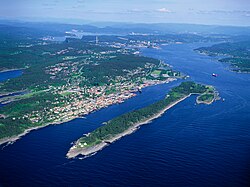
is a municipality in Telemark county, Norway. It is located in the traditional district of Grenland. The administrative centre of the municipality is the city of Porsgrunn. Some other notable settlements in Porsgrunn include the town of Brevik and the villages of Langangen and Heistad.

is a municipality in Innlandet county, Norway. It is located in the traditional district of Gudbrandsdal. The administrative centre of the municipality is the village of Vålebru.

Vestre Toten is a municipality in Innlandet county, Norway. It is located in the traditional district of Toten. The administrative centre of the municipality is the village of Raufoss. Other villages in the municipality include Bøverbru, Eina, and Reinsvoll.

Nøtterøy is a former municipality in Vestfold county, Norway. The 61-square-kilometre (24 sq mi) island municipality existed from 1838 until its dissolution on 1 January 2018. The area is now part of Færder Municipality. The administrative centre was the village of Borgheim. Other villages in Nøtterøy included Årøysund, Buerstad, Duken, Føynland, Glomstein, Hårkollen, Kjøpmannskjær, Nesbrygga, Oterbekk, Skallestad, Skjerve, Strengsdal, Tenvik, Torød, Vestskogen, and Vollen. The whole northern part of the municipality was considered to be part of the city of Tønsberg metropolitan area.

Lardal is a former municipality in Vestfold county, Norway. The 278-square-kilometre (107 sq mi) municipality existed from 1838 until its dissolution in 2018. The area is now part of Larvik Municipality. The administrative centre was the village of Svarstad. The village of Steinsholt was also part of Lardal.

Siljan is a municipality in Telemark county, Norway. It is located in the traditional district of Grenland. The administrative centre of the municipality is the village of Siljan. Other villages in Siljan include Snurråsen and Øverbø.

Hjartdal is a municipality in Telemark county, Norway. It is located in the traditional district of Upper Telemark and Aust-Telemark. The administrative centre of the municipality is the village of Sauland. Other villages in the municipality include Tuddal and Hjartdalsbygda.
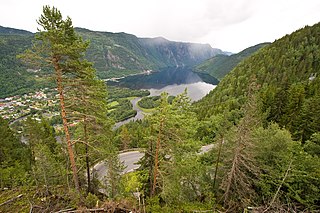
Tokke is a municipality in Telemark county, Norway. It is located in the traditional district of Vest-Telemark. The administrative centre of the municipality is the village of Dalen. Other villages in Tokke include Åmdals Verk, Eidsborg, Høydalsmo, Lårdal, and Øvre Byrte. The Eidsborg Stave Church is one of Norway's old stave churches and it is located in Eidsborg, just north of Dalen.
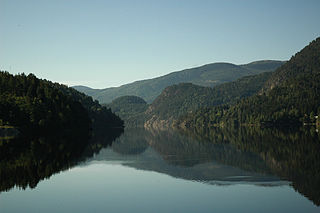
Kviteseid is a municipality in Telemark county, Norway. It is located in the traditional districts of Vest-Telemark and Upper Telemark. The administrative centre of the municipality is the village of Kviteseidbyen. Other villages in Kviteseid include Åsgrend, Brunkeberg, Eidstod, Fjågesund, Kilen, Morgedal, and Vrådal.
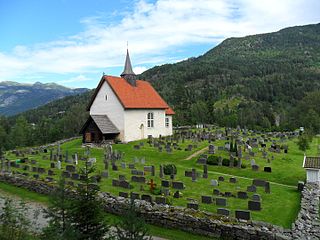
Seljord is a municipality in Telemark county, Norway. It is located in the traditional districts of Upper Telemark and Vest-Telemark. The administrative centre of the municipality is the village of Seljord. Other villages in the municipality include Flatdal and Åmotsdal.

Vinje is a municipality in Telemark county, Norway. It is located in the traditional district of Vest-Telemark which is part of Øvre Telemark. The administrative centre of the municipality is the village of Åmot. Other villages in the municipality include Arabygdi, Edland, Grunge, Haukeli, Krossen, Møsstrond, Nesland, Øyfjell, Raulandsgrend, and Vinje.

Drangedal is a municipality in Telemark county, Norway. It is located in the traditional district of Grenland. The administrative centre of the municipality is the village of Prestestranda. Other villages in Drangedal include Bø i Tørdal, Bostrak, Gautefall, Henseid, and Neslandsvatn.

Sauherad is a former municipality in Telemark county, Norway. It was part of the traditional region of Midt-Telemark. The 321-square-kilometre (124 sq mi) municipality existed from 1838 until its dissolution in 2020. The area is now part of Midt-Telemark Municipality and Notodden Municipality. The administrative centre was the village of Akkerhaugen. Other villages in the municipality included Gvarv, Holtsås, Hjukse, Hjuksebø, Nordagutu, and Sauherad. Sauherad bordered the municipalities of Kongsberg, Skien, Nome, Bø, and Notodden.
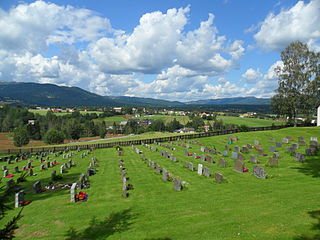
Bø is a former municipality in Telemark county, Norway. It was part of the traditional region of Midt-Telemark, but was historically regarded as part of Grenland. The 263-square-kilometre (102 sq mi) municipality existed from 1838 until its dissolution in 2020. The area is now part of Midt-Telemark Municipality. The administrative centre was the village of Bø i Telemark. Other villages in the municipality included Folkestad and Nordbøåsane.
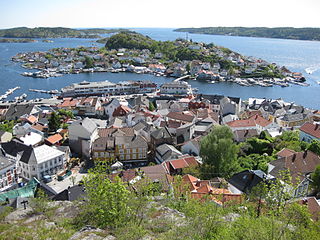
Kragerø is a municipality in Telemark county, Norway. It is located in the traditional districts of Grenland and the smaller Vestmar. The administrative centre of the municipality is the town of Kragerø. Villages in Kragerø include Helle, Vadfoss, Kil, and Portør.
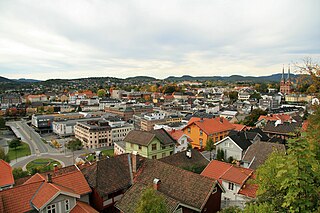
Skien is a municipality in Telemark county, Norway. It is located in the traditional district of Grenland, although historically it belonged to Grenmar/Skiensfjorden, while Grenland referred the Norsjø area and Bø. The administrative centre of the municipality is the city of Skien, which is also the administrative centre of the whole county. Some of the notable villages in the municipality include Åfoss, Hoppestad, Klovholt, Luksefjell, Melum, Kilebygda, Skotfoss, Sneltvedt, and Valebø.

is a municipality in Telemark county, Norway. It is located in the traditional district of Aust-Telemark. The administrative centre of the municipality is the town of Notodden. Other population centres include the villages of Bolkesjø, Gransherad, Heddal, Hjuksebø, Hjuksevelta, Rudsgrendi, Tinnoset, and Yli.
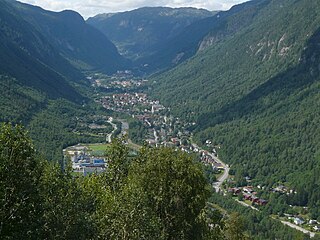
Tinn is a municipality in Telemark county, Norway. It is located in the traditional districts of Aust-Telemark and Upper Telemark. The administrative centre of the municipality is the town of Rjukan. Some of the villages in Tinn include Atrå, Austbygde, Hovin, and Miland.

Nome is a municipality in Telemark county, Norway. It is located in the traditional district of Midt-Telemark and historically part of the Grenland region. The administrative centre of the municipality is the village of Ulefoss. Other villages include Bjervamoen, Ulefoss, Helgja, Flåbygd, and Svenseid.

is the administrative centre of Bamble Municipality in Telemark county, Norway. The town is located on a peninsula along the Langesundsfjorden near the Skaggerak coast. The town of Stathelle lies about 4 kilometres (2.5 mi) to the northwest. The 0.88-square-kilometre (220-acre) town was established as a ladested in 1765 and on 1 January 1838 it became a self-governing municipality. In 1964, it became part of Bamble Municipality.
